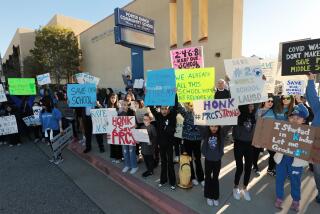Index ranks L.A.’s neediest schools, seeking funds
A citywide coalition of community groups and civil rights leaders unveiled a comprehensive new measure Monday ranking L.A. Unified’s neediest schools and urged more targeted spending on students there.
The “student need index,” which analyzed test scores, dropout rates, gun violence, asthma and eight other factors that affect learning, found that the neediest schools were concentrated in southern and eastern Los Angeles, along with the Pacoima area in the San Fernando Valley. The schools included Fremont and Jordan high schools, Bethune and Drew middle schools and Griffith Joyner and Woodcrest elementary schools.
Activists praised L.A. Unified Supt. John Deasy’s draft budget released last week, which directed $837 million to students who are low income, not fluent in English and in foster care, as required under the new state school finance law. But they urged that the majority of that money be spent in the 242 schools they identified as the neediest and pressed for a more targeted plan to boost services at those campuses.
“We’re trying to push the district to be smart about how they invest resources and be bold and courageous about advancing justice by targeting schools with high needs,” said Alberto Retana of the Community Coalition.
Deasy said that his budget absolutely directs the extra money received for disadvantaged students to programs and services that benefit them. It provides teacher training and support, for example, to urban schools with high staff turnover rates.
But community activists called for more at a rally at L.A. Unified headquarters Monday, where 14 organizations and students from eight south and east L.A. high schools marched together, chanting and carrying signs.
Azucena Sifuentes, a senior at Manuel Arts High, said her school struggles with tattered textbooks and insufficient copy paper. Evelin Rivas, a Fremont High junior, lamented over a shortage of Advanced Placement classes and sports equipment and uniforms. Crenshaw High lacks enough computers and a stable teaching force, said Gwen Bynoe, a junior.
Marqueece Harris-Dawson, Community Coalition president, said the draft budget doesn’t adequately show how the dollars for needy students are spent on either their individual needs or the schools they attend. It allocates money for counselors districtwide to work with foster youth rather than more heavily at schools where the students are concentrated, he said.
“The budget is headed in the right direction, but it’s still unclear where the dollars end up and who it ends up with,” he said.
John Kim of the Advancement Project, a civil rights organization that developed the ratings, said comprehensive services at the neediest schools would be far more effective in boosting achievement than scattershot spending across the district.
Deasy’s proposed budget, for instance, allocates $660,000 for five counselors trained in an alternative conflict-resolution method known as restorative justice. But Kim and others questioned how effective such a limited investment would be in a district of nearly 1,000 schools and 656,000 students.
The coalition has proposed its own spending plan that includes boosting academic supports, healthcare and parent involvement. Members are also pushing for money to be spent to shift discipline practices to such alternatives as restorative justice programs rather than suspensions, expulsions and police citations.
“To deal with the multiple challenges these kids face, you need a comprehensive approach,” Kim said. “You can’t sprinkle services here and there.”
Some have argued, however, that the new state funds should follow the disadvantaged students to their campuses — even if they are located in middle-class neighborhoods.
Coalition members were expected to turn in 2,500 postcards Tuesday signed by students in south and east Los Angeles, urging district officials to give more dollars to their schools.
teresa.watanabe@latimes.com
More to Read
Start your day right
Sign up for Essential California for news, features and recommendations from the L.A. Times and beyond in your inbox six days a week.
You may occasionally receive promotional content from the Los Angeles Times.







